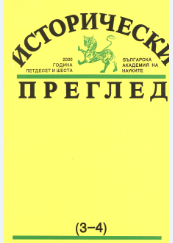Котис I като „Паис“ на Аполон и трако-гръцките контакти през първата половина на IV в. пр. Хр.
Kotys I as “Pais” of Apollo and the Thraco-Greek Contacts during the First Half of the 4th Century В. C.
Author(s): Kamen D. DimitrovSubject(s): History, Archaeology, Cultural history, Ancient World
Published by: Институт за исторически изследвания - Българска академия на науките
Keywords: Rogozen Treasure; Kotys I; Odrysian Kingdom; Thracian / Orphic ideology
Summary/Abstract: Jug № 112 of the Rogozen Treasure carries a Greek inscription which reads in translation “Kotys son (servant) of Apollo”. In the scientific literature, see notes 1-10, together with phials № 43 and 101-103 with a head of Apollo? On the umbo, the jug is interpreted as a vessel of “Apollonian set”, presented by the Odrysian ruler Kotys I (384/2–359 В. C.) to the dynast of the Triballi for initiation into the Orphic Sun religion, on the occasion of an important political contact. The Odrysian king styled himself as the son of the Thracian God of the Sun Orpheus, Apollo in his Hellenized variant. The same author believe that the Orphic religious doctrine was implemented through the royal economy, a monopoly of the king and controlled by him through the fortified “royal cities” in his absolute possession. The basic difference from the Hellenic economy and existence “by poleis” was the cause for the difference between the Thracian (Orphic) and the Hellenic ideology. The latest archaeological discoveries speak of a dualistic economic model in Thrace in the late 5th — first half of the 4th c. В. C. Production was effected through the royal economy and the export of goods and their realization in money — through the structures of the Greek poleis. The interaction between them was reflected in the inscription from the Greek emporium Pistiros, in the treasures with coins of Greek cities in Inner Thrace, in the pieces of information about the production and sale of grain and war booty by the Thracian kings in the Greek poleis. Fortresses and emporia of the latter existed also in Inner Thrace, see notes 15–19. In the Odrysian Kingdom were incorporated also such Greek cities as Byzante and Cardia, with preservation of their own jurisdiction and self-government as in Pistiros. Probably such were also some inhabited localities, today regarded as “royal cities”. It is not known whether the king wielded absolute authority in them. The life contacts between Thracians and Hellenes imposed also the use of ideologemes that were understood by everybody. The Hellenic Pantheon was more convenient on account of its democratism, whereas the Thracian Orphic religion was accessible in its full form only to the initiated. There is information cibout the religious thinking of a Hellenic type (at least on a pragmatic political level) and about the failure to understand the Orphic postulates in the Thracian royal environment, see notes 36, 37. The rebellion against the king of Hieron Oros in essence rejected the fundamental social meaning of the teaching about the divine inviolability of royal power. The place was ritual for the Orphic doctrine, see note 40. The facts impose an alternative interpretatio thracohellenica about certain works of art from Thrace, hitherto regarded as purely Orphic. The criterion is the language of expression; the absence of market solar symbolism, the use of the written Greek language and theonymy. The latter desacralized the teaching and violated the principle of its spreading without writing. Jug № 112 is precisely such a monument. Its language of expression is quite different from that of its contemporary gold jug from the Mogilanska mound near Vratsa, a typical Orphic monument without inscription, with the image of the dynast in a winged chariot. Jug №112 was not used for initiation into the Orphic religion in a closed Odrysian-Triballic cultural space. More probably it is a present from Kotys I from a vassal Hellenic or Hellenized inhabited locality (Ergiske?) as J. Hind assumes, see note 11. The formula “servant of Apollo” puts Kotys I on the same level with the high Greek magistrates — the archons, participants in the cult of Apollo Patroos. In this way were emphasized the legitimacy and acceptable face of the royal authority over Hellenic or Hellehized communities. The ideologeme is an adequate repercussion of the policy of Kotys of a balance between different ethno-cultural communities and social forms in the Odrysian Kingdom.
Journal: Исторически преглед
- Issue Year: 2000
- Issue No: 3-4
- Page Range: 3-15
- Page Count: 13
- Language: Bulgarian
- Content File-PDF

